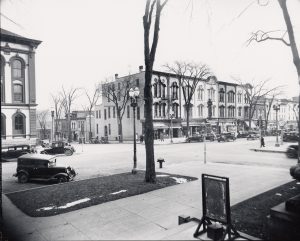
Ainsworth Building, 1930
I don’t think there is a person who resides in or visits Saratoga Springs who doesn’t enjoy looking at the historic images of Saratoga Springs and taking a step back in time to see people strolling in front of the grand hotels that once graced Broadway, the tree-lined streets with mansions, and crowds watching horses at the Saratoga Race Course. As a community we should appreciate the treasure trove of iconic images that exists today and that they would not exist without George S. Bolster, a local professional photographer.
Born in 1913, George Bolster became intrigued by photography at age ten, when he made a box camera and took pictures of neighborhood kids and dogs. Observing this interest, Bolster’s uncle introduced young George to a Harry B. Settle, a prominent local photographer, a friendship that would come full circle after Settle’s death when, in 1958, Bolster moved into Settle’s studio at 1 Phila Street. Later, Bolster also would acquire Settle’s massive collection of photographs, many of which had been produced on glass plates.
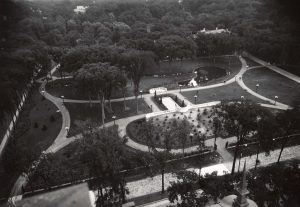
Congress Park, 1910
Instilled with a love of local history, Bolster in subsequent years bought or otherwise obtained every photo of Saratoga Springs he could find. By the time Mastrianni met him 1981, he had collected some 325,000 images, many of which are of “old Saratoga” dating as far back as 1855.
“Someone said, ‘You have to meet George Bolster,’ so I walked down there one day,” Mastrianni recalls. “There he was, drinking his vichy and hand-coloring photographs. I said, ‘Those are transparent oils, right?’ He grumbled a bit, but we hit it off.”
A Skidmore-trained sculptor and painter, Mastrianni was working with the Saratoga Springs History Museum at that time on the launch of an art gallery at the Casino. For the gallery she arranged the The Saratoga Album, the first exhibit of photos from his collection. It was a tremendous success. For the next eight years, until Bolster’s death in 1989, Mastrianni regularly went to his studio to work with him in cataloging and properly archiving the collection. It was a major commitment of time and effort, and expensive, but the rewards were far worth it.
Mastrianni credits a long list of Saratogians for their role in preserving the Collection. For their financial support, she points to local developer Bill Grande; Charles Wait, chairman, chief executive officer, and president of Adirondack Trust Company; William Dake, chairman of Stewart’s Shops; and Wally Allerdice, owner of Allerdice Building Supply. Others who have provided key assistance include Susan Brome, who succeeded Mastrianni as the Collection’s director; attorney Harry Snyder; businessman Norman Fox; the late John T. Roohan, founder of Roohan Realty; and a long list of volunteers.
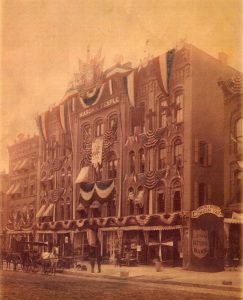
Masonic Temple. year unknown
In 1990, she teamed with journalist Chris Carola and photographer Michael Noonan, Bolster’s long-time apprentice and assistant, in publishing George S. Bolster’s Saratoga Springs, a coffee-table book containing 300 of the Collection’s most remarkable images. Sales generated $60,000 to go towards preserving the Collection, which Bolster willed to the Saratoga Spring History Museum. This was in addition to substantial sums of money that were raised earlier to purchase archival supplies; underwrite the Bolster’s studio until 1997, when it moved permanently to the Saratoga Springs History Museum; and employ Michael Noonan to assist with the production of prints.
When Mastrianni first started to work with the Collection, “The city was a wreck, and here were all of these photos that showed its glory in another time,” she says. “In these photos of fashionable families and beautiful homes, we could see what Saratoga once was and what it could be again. As I looked around, I could see there were a lot of people who shared that vision. This was Saratoga’s story.”
Michael Ingersoll, founding principal of The LA Group, found similar inspiration in George’s photographs in those days. “When Mr. Bolster was alive, we often would visit his shop to gain insight to what was once in the place of the many vacant sites in the city,” he says.
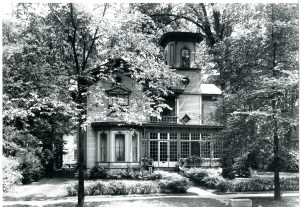
34 Circular Street, 1939
“The George S. Bolster Collection has gone a long way in helping the design of new buildings and making the review process more successful for everyone,” Ingersoll adds. “It has become a standard resource for our office and is often the first place we start.” The Price Chopper Limited development on Railroad Place, 18 Division Street, and the current project on the former parking lot at 422 Broadway that will be home to Northshire Books, have taken cues from historic images of the George S. Bolster Collection.
For architects, developers, and homeowners who want to understand a property’s historic context, the collection is an invaluable resource. Many restoration projects throughout the City have benefited from early research based on the Collection including those at Yaddo and Congress Park, including Spit and Spat and the Spirit of Life & Spencer Trask Memorial.
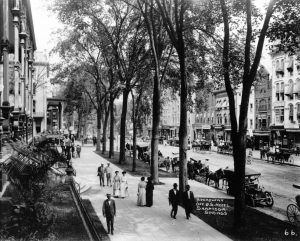
United States Hotel, year unknown
“You can talk all you like about what Victorian houses are like, and how Victorian people dressed, but when you see the pictures you really understand what it was. And you can really understand what Broadway was – the stores and the places people went to eat. It was very different from today,” Mastrianni says.
Mastrianni still has in her possession 50 hours of interview recordings she made with Bolster while cataloging the Collection. Some day, she hopes funds will be raised to sync this audio with the photos that Bolster was discussing along with images of the properties as they appear today, and place it online.
Jamie Parillo, director of the Saratoga Springs History Museum, concurs. “Because of George Bolster’s commitment to preserving this Collection it has remained intact in Saratoga Springs at the History Museum,” he says. “Our goal is to make everyone aware of its significance and make it easily accessible to anyone who is researching Saratoga Springs for academic or professional use or for those who simply enjoy learning about the history of our city.”
Founded in 1977, the Saratoga Springs Preservation Foundation is a private, not-for-profit organization that promotes preservation and enhancement of the architectural, cultural and landscaped heritage of Saratoga Springs.
